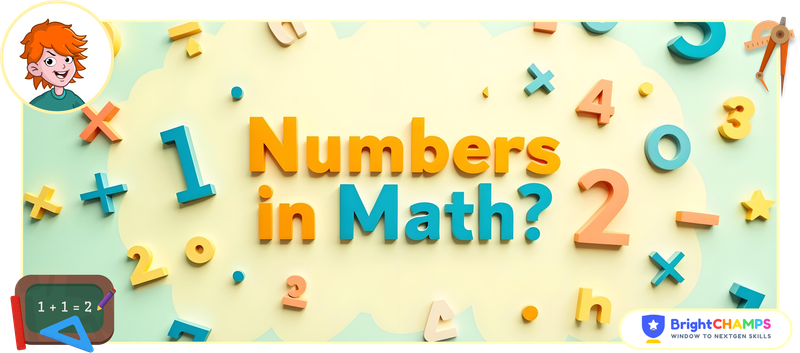
1318 Learners
Numbers
Numbers are among the most important concepts in mathematics. Without our notice, we apply numbers in our day-to-day lives. We use numbers daily for activities like setting alarms, budgeting, managing time, and increasing productivity at work.
Share Post:
Trustpilot | Rated 4.7
1,292 reviews
Math Calculators
Math Formulas
Math Questions
Math Worksheet
Math Puzzles
What are the Numbers in Math?
The most essential and basic mathematical concepts used for calculation and measurement are numbers. There are different kinds of numbers like composite, prime, rational, irrational, odd, even, integers, complex, and many more. We represent different values or quantities in numbers.

History of Numbers

Initially, numbers were represented by basic symbols. Over time, humans created different unique symbols to represent them.
- Greek scholars like Pythagoras and Euclid studied numbers to understand the world better.
- The ancient Romans around 500 BCE started a Roman numeral system. Roman Numerals consist of letters like I, V, X, L, C, D, and M to represent numbers. There is no symbol for zero in Roman Numeral.
- Around 500 CE, Aryabhata introduced the concept of zero in mathematics.
- Aryabhata also invented the decimal system using numbers 0 to 9.
- The Hindu-Arabic numeral system is used today.
Properties of Numbers
By now you must have got an idea of what numbers are. So now, let’s discuss some mathematical operations like addition, multiplication, and division. Numbers have certain rules to make it easier.
1.Commutative Property : This method tells us the order of numbers does not matter.The result is the same regardless of the order.We apply commutative property in addition and multiplication.
Example:
Addition: 2+3 = 3+2 = 5
Multiplication: 4×5 = 5×4 = 20
2.Associative Property:This property shows us that the way numbers are grouped does not affect the result.
It is applied in addition and multiplication.
Example of Associative property of addition and multiplication:
Addition: (1+2) + 3 =1 + (2+3) = 6
Multiplication: (2×3) x 4 = 2 x (3×4) = 24
3.Distributive Property: Multiplying a number with a sum or difference gives the same result as doing each multiplication separately.Distributive property is about simplifying a tough problem to make calculations easy.
A factor can be distributed to each member of a group of numbers that have been subtracted or added.
The factor is distributed and multiplied separately by each term in the group.Instead, it's distributed and multiplied separately by each member of the group.
Example of distributive property of addition:
2 x (3+4) = (2×3) + (2×4) = 14.
4.Identity Property: The identity property tells us that a few operations leave numbers unchanged.
In addition, adding 0 to a number does not change it.
In multiplication, multiplying 1 does not change the number.
Example for identity property:
Addition: 5 + 0 = 5 and Multiplication: 8 × 1 = 8
5.Inverse Property : In the inverse property, the effect of an operation is reversed:
Additive inverse: Adding a number to its additive inverse results in 0. Example: 6+(-6)=0.
Multiplicative inverse: Multiplying a number by its reciprocal gives one.
Example: 5 x (1/5) = 1
5.Closure Property: Closure property is when we perform a certain operation on two numbers, which will result in a number within the same set.
For instance, we get a whole number if we add two whole numbers together. However, when subtracting two natural numbers may not give a natural number.
Example:
Integers : 5 + 2 = 7 (an integer)
Whole numbers: 4 × 3 = 12 (a whole number)

Classification of Numbers
Numbers can be grouped into different. Depending on how we use them and their characteristics. Let’s get to know more about numbers:
1. Natural Numbers:
Natural numbers are used for counting, starting from 1 and going on to infinity.
These numbers are represented by the letter ‘N’.
For example: N=1,2,3,4,5,...........
2. Whole Numbers :
The whole numbers consist of all natural number and 0
They are represented by the letter ‘W’.
For example W=0,1,2,3,4,5,...........
3. Integers:
Integers are numbers that can either be positive, negative, or zero.
They do not include fractions or decimals.
For example: -2,-1,0,1,2,.....
3.Rational Numbers:
A number that can be written as a fraction.
It is represented in the pq form, where q is not equal to 0 and both p, q are integers.
For example: 1/2,-3,0.57.
4. Irrational Number:
Irrational numbers cannot be written as fractions.
It cannot be represented in the form of p/q where both p, q are integers.
For Example: π , √2.
4. Real Number:
All the rational and irrational numbers form a group of real numbers. For example, 2,-5, √3 , 0.5, .
5.Complex Numbers:
Complex numbers are divided into parts: real and imaginary. Here, a+bi; i=√-1.

Importance of Numbers for Students
Numbers are everywhere in our daily lives! They help us count, measure, and solve problems in school and in real life.
Types of Numbers
1. Cardinal and Ordinal Numbers
- Cardinal numbers are the numbers that tell us ‘how many’. E.g., 1,2,3…
- Ordinal numbers are the numbers that show the position or rank. E.g., 1st, 2nd, 3rd….
2. Even and Odd Numbers
- Even numbers: Numbers divisible by 2 e.g., 2, 4, 6.
- Odd numbers: Numbers that are not divisible by 2 e.g.,1,3,5.
3. Consecutive Numbers
- Numbers that follow one number after the other number in an order. E.g., 1, 2, 3 or 5, 6, 7
4. Prime and Composite Numbers
- Prime: The numbers that can only be divided by 1 and the number alone. E.g., 2, 3, 5
- Composite: Any number that has divisors more than the number two. E.g., 4, 6, 8
5.Co-Prime Numbers
For co-prime numbers, two numbers that share no common factors other than 1. E.g., 8 and 15 areco-prime because they have 1 common factor that is 1. But 15 and 9 are not co-prime numbers, they have 3 as a common factor.
6.Perfect Numbers
- A perfect number is a positive integer which is equal to the sum of its factors or positive divisor excluding the number itself
For example, 28 the divisors are 1, 2, 4, 7, and 14, and by adding them we get 28
7.Fractions and Decimals
- Fractions are the numbers that show a part of the whole. Example: 12
- The decimals show the number in the base 10. Example: 0.5.
8. Factors and Multiples
- Factors are the numbers that divide any number without leaving any remainder. Example: Factors of 12 are 1, 2, 3, 4, 6, and 12.
- Multiples are the result of multiplying a number by an integer. Example: Multiples of 3 are 3, 6, 9, 12, etc.
9. GCF and LCM
GCF (also known as HCF) is the greatest common factor two numbers share. Example: GCF of 12 and 18 is 6 because it divides both. LCM is the least common multiple that two numbers share. Example: LCM of 4 and 6 is 12.
10.Prime Factorization
- The breaking down of numbers into their factors. Example: prime factors of 18 are 2×3×3.
11. Algebraic and Transcendental Numbers
- Algebraic numbers are the numbers that solve polynomial equations. Example: 2
- Transcendental numbers are the numbers that do not solve polynomial equations. Example:
Tips and Tricks to Learn Numbers
Understanding numbers can be made simpler using a few tricks. Assume we are playing a game, the more we practice, the easier it gets. Here are a few tips and tricks that can make understanding numbers easier.
- Think about how you use numbers every day. For example, if your alarm is set for 6:48 am, you can break it down to see how many minutes you have left to sleep.
- Use distributive property: Big numbers may sometimes seem scary, so you can break them down into small numbers. Why not try dividing them into parts? For Example: 48 + 36
Group the numbers according to their place values,
40 + 8 = 48; 36 = 30 + 6
Now add the numbers in the tens place and one's place,
40 + 30 = 70; 8 + 6 = 14; 70 + 14 = 84
- Rounding numbers for estimations to make calculations easier. For example, to add 487 + 293, round off to 490 + 290 = 780. Then we can refine the end solution.
- Use the rule of divisibility, when the last digit is even, 0 or 5 it is 2 and 5 respectively. The sum of digits is divisible by 3 then the number is 3.

Common Mistakes and How to Avoid Them in Numbers
While we learn about numbers, children are likely to get confused, considering there are separate topics that we learn about. Given below are a few mistakes that children make and how to avoid them.
Real-World Applications of Numbers
Numbers are an important part of our daily lives. Numbers are used for the simplest form of work to a complex one. Here are a few real-world applications of numbers:
1. Budgeting and accounting:

1. Budgeting and accounting:
Ever wondered how you manage your pocket money, plan a trip, or save up for something you want to buy? That's numbering at work, balancing income, and other goals we want to reach.
2. Precision in the Kitchen:

2. Precision in the Kitchen:
While cooking or baking, the right measurement/quantity of ingredients is very crucial.
3. Mastering the Clock:

3. Mastering the Clock:
Time management in scheduling appointments, catching buses, or setting alarms.
4. Technology and computing:

4. Technology and computing:
In algorithms, computers use binary numbers 0s and 1s.
5. Sports:

5. Sports:
Used in sports for calculating timing and statistics.
6. Medicine:

6. Medicine:
Medicine dosage calculations, MRI scans, X-rays, etc.
Numbers are an important part of our daily lives. Numbers are used for the simplest form of work to a complex one. Here are a few real-world applications of numbers:

Examples of Numbers

Problem 1
Find the missing two numbers if the sum of 2 consecutive natural numbers is 37.

Let the two consecutive natural numbers be x and x+1.
x + (x+1) = 37
2x + 1 = 37
2x = 36
x = 18
Therefore, x + 1 = 19
Explanation
The two consecutive natural numbers are 18 and 19. The sum of 18 and 19 is 37.

Problem 2
Check whether 15 and 28 are co-prime.

To Check if 15 and 28 are co-prime,
The prime factors of 15 = 3 × 5
The prime factors of 28 = 2 × 2 × 7
Hence, there are no common factors other than, 1, 15 and 28 are co-prime
Explanation
Co-prime numbers have only 1 common factor between them, that is 1. Here, 15 and 28 have only 1 in common. Therefore, they are co-prime numbers.

Problem 3
Find the quotient of 8/3 ÷ 2/3.

To divide, 8/3 ÷ 2/3
Multiplying 8/3 with the reciprocal of 2/3
That is, 8/3×3/2 = 24/6
Simplifying the fraction, 24/6 = 4
Explanation
To divide a fraction, we multiply the first fraction with the reciprocal of the second fraction. When we divide the given fractions, we get the quotient to be 4.

Problem 4
Show that 5 + 7 is the same as 7 + 5.

Add in the given order, 5 + 7 = 12.
Swap the order, 7 + 5 = 12.
Explanation
The commutative property of addition says the order doesn’t matter. So, 5 + 7 and 7 + 5 both give the same result: 12.

Problem 5
Simplify (2 × 3) × 4 and 2 × (3 × 4).

First group: (2 × 3) = 6 → 6 × 4 = 24.
Second group: (3 × 4) = 12 → 2 × 12 = 24.
Explanation
The associative property says grouping doesn’t change the result in multiplication. So both methods give the same answer: 24.


FAQs on Numbers
1.Define natural numbers.
2.What are odd numbers?
3.What does Z mean in math?
4.What is a rational number?
5.What are prime numbers?
6.How can children in Bahrain use numbers in everyday life to understand Numbers?
7.What are some fun ways kids in Bahrain can practice Numbers with numbers?
8.What role do numbers and Numbers play in helping children in Bahrain develop problem-solving skills?
9.How can families in Bahrain create number-rich environments to improve Numbers skills?


Hiralee Lalitkumar Makwana
About the Author
Hiralee Lalitkumar Makwana has almost two years of teaching experience. She is a number ninja as she loves numbers. Her interest in numbers can be seen in the way she cracks math puzzles and hidden patterns.
Fun Fact
: She loves to read number jokes and games.




